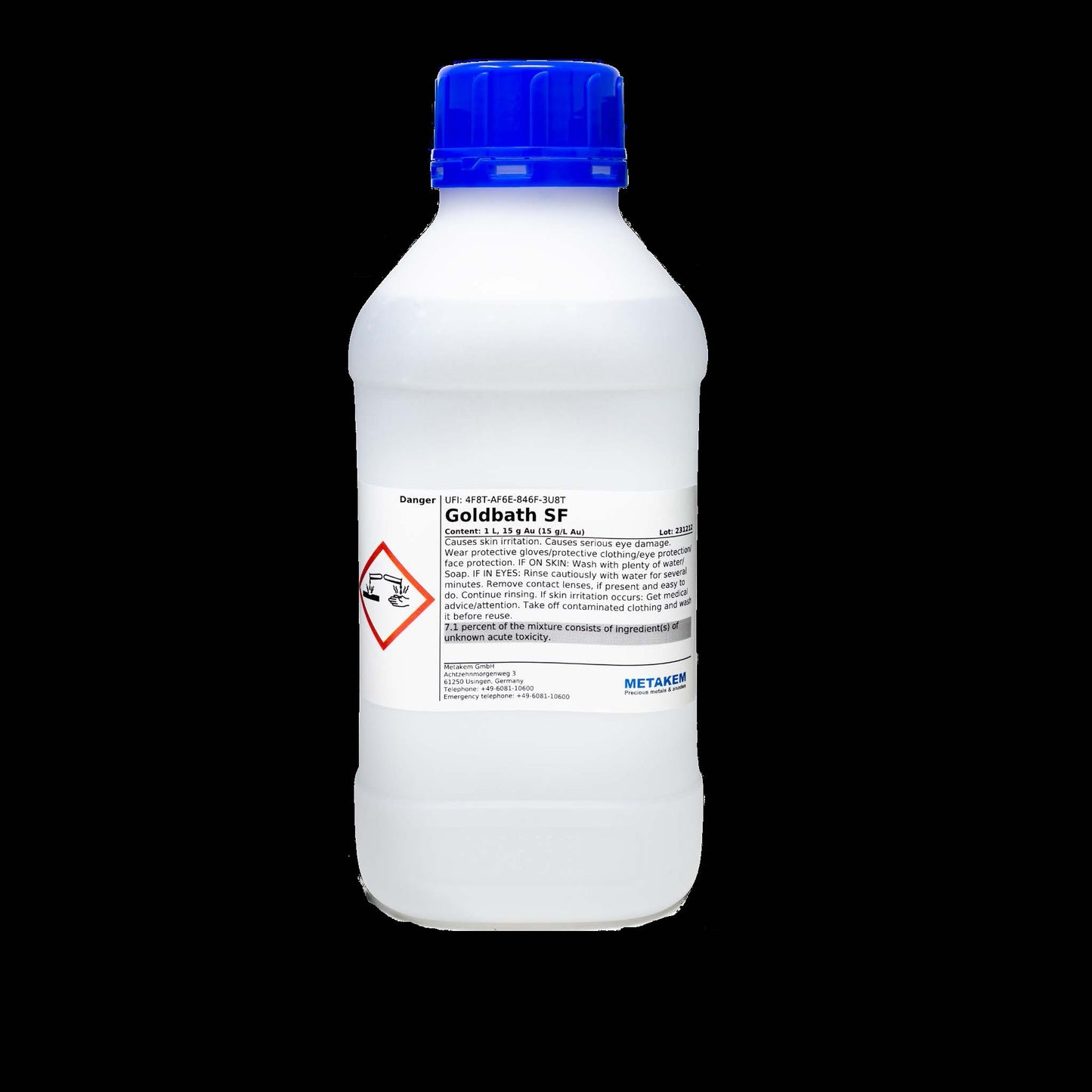1
/
of
1
Manufactured by Metakem, sold by Nano Cats GmbH
Gold SF Bath
Gold SF Bath
Regular price
€1.170,00 EUR
Regular price
Sale price
€1.170,00 EUR
Unit price
/
per
Couldn't load pickup availability
Gold-SF-Bath
A high-quality cyanide-free gold electrolyte designed for technical and decorative applications. The bath is sulfite-based and delivered ready to use; dilution is not permitted.
| Property / Parameter | Value / Description |
|---|---|
| Gold Content | 10 – 15 g/l (range: 0 – 20 g/l) |
| pH Value | 7.5 (range: 7.2 – 8.0) |
| Operating Temperature | 60 °C (range: 55 – 65 °C) |
| Anode Material | Platinum/Titanium |
| Current Density | 1 A/dm² (range: 0.1 – 2 A/dm²) |
| Voltage | 0.6 V (range: 0.5 – 0.8 V) |
| Cathodic Efficiency | 122 mg / Amines (approx. 0.6 μm / min at 1 A/dm²) |
| Bath Agitation | Mechanical stirring > 5 m/min or appropriate movement of parts |
| Container | Glass or plastic (PP, PVDF) |
| Heater | Glass or PTFE coated |
| Stirring | Vigorous circulation via stirrer or linear movement |
Gold Layer Properties
- Gold purity: 99.9%
- Density: 9.3 g/cm³
pH Adjustment
- During open bath operation, ammonia may evaporate requiring pH correction using 25% ammonia solution.
- If pH is raised too high, it can be corrected using 50% phosphoric acid, added carefully at room temperature with vigorous stirring to avoid decomposition of the gold complex and local over-acidification ("brown clouds").
Bath Management & Storage
- After use, store bath in closed containers made of PE, PP, or PET, preferably full to reduce air oxidation of sulfite to sulfate.
- Open baths left for extended periods may turn violet (due to gold precipitation from sulfite loss).
- Violet coloration can be reversed by adding ammonium sulfite, but precipitated gold cannot be redissolved.
- Filtration of sedimented gold flakes or chips does not impair bath functionality.
- No need for bath reconditioning after pauses in use.
- Gloss additives oxidize slowly in air; brown and dull deposits indicate the need to add approximately 5 ml of Gold-SF gloss additive per liter of bath.
Bath Monitoring
- Daily pH control recommended for open baths.
- Sulfite normally released from gold complex exceeds oxidation, compensating for air oxidation.
- After long idle periods, sulfite content (SO3²⁻) can be titrated with iodine after masking gold with cyanide, should be between 15 and 30 g/l.
- Remaining gold content is easiest calculated based on charge passed; can also be assayed gravimetrically or via ICP analysis.
Analytical Methods
- Sulfite control: Titrate 10 ml deionized water with 1 ml sample, 1 ml 0.2 M KCN, acidified to pH 4 with acetic acid, add soluble starch, titrate with 0.1 N iodine; 1 ml iodine corresponds to approx. 4 g sulfite.
- Gold analysis: Heat 50 ml bath diluted to 150 ml with DI water to near boiling under watch glass. Carefully acidify with sulfuric acid and oxidize excess sulfite with hydrogen peroxide. Gold precipitates as brown cake. When solution clears, filtration, washing, and weighing of residue after ignition are done.
Notes
- Cyanide must never enter the bath as it destroys it; rinse thoroughly after cyanide pretreatment.
- Bath can be fully worked down with decreasing current density with no brown gold deposits forming.
- For continuous gold addition instead of bath run-down, gold supplement allows up to five-fold use of the bath, but only one-third of gold content should be removed at once.
- If brown dull deposits appear first, add gloss additive to restore shiny, gold-colored layers.
Share

